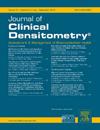Analysis of Changes in Bone Mineral Density by Disability Level in Patients with Myotonic Dystrophy Myopathy
IF 1.6
4区 医学
Q4 ENDOCRINOLOGY & METABOLISM
引用次数: 0
Abstract
Purpose/introduction: The aim of this study was to determine which method can determine bone mineral changes in patients with Myotonic Dystrophy at an early age by applying age classification and Modified Rankin Scale for Neurological Disability (MRSND).
Methods: This descriptive, cross-sectional and retrospective study was conducted in 52 myopathy patients diagnosed with myotonic dystrophy. Analyses were performed using SPSS 25 and STATA 14. Frequency and percentage, mean and standard deviation values were reported and Pearson correlation, t-test, ANOVA and multiple linear regression analyses were performed. Confidence levels of 0.10, 0.05 and 0.01. The study complies with the Strengthening the Reporting of Observational Studies in Epidemiology (STROBE) statement guidelines for reporting cross-sectional studies (STROBE CHECKLIST).
Results: According to the regression analysis results, body mass index had a positive effect on Femoral Z Score (p < 0.01). In addition, vitamin D had a positive effect on Femoral Z Score (p < 0.05). On the other hand, MRSND had a negative effect on Femoral Z Score (p < 0.01).
Conclusion: Myotonic dystrophic myopathy has been shown to impair the mineral structure of bone. Patients with this condition have been shown to recognize possible changes in their bones earlier in using the MRSND scale.
强直性肌营养不良肌病患者骨密度随残疾程度变化的分析
目的/简介:本研究的目的是通过年龄分类和改良Rankin神经功能障碍量表(MRSND)来确定哪种方法可以确定肌强张性营养不良患者早期骨矿物质的变化。方法:对52例诊断为强直性肌营养不良的肌病患者进行描述性、横断面和回顾性研究。采用SPSS 25和STATA 14进行分析。报告频率和百分比、均值和标准差值,并进行Pearson相关、t检验、方差分析和多元线性回归分析。置信水平为0.10、0.05和0.01。本研究符合加强流行病学观察性研究报告(STROBE)声明横断面研究报告指南(STROBE CHECKLIST)。结果:根据回归分析结果,体重指数对股骨Z评分有正向影响(p <; 0.01)。此外,维生素D对股骨Z评分有正向影响(p <; 0.05)。另一方面,MRSND对股骨Z评分有负向影响(p <; 0.01)。结论:肌强直性营养不良肌病已被证明会损害骨的矿物质结构。患有这种疾病的患者在使用MRSND量表时可以更早地识别出骨骼可能发生的变化。
本文章由计算机程序翻译,如有差异,请以英文原文为准。
求助全文
约1分钟内获得全文
求助全文
来源期刊

Journal of Clinical Densitometry
医学-内分泌学与代谢
CiteScore
4.90
自引率
8.00%
发文量
92
审稿时长
90 days
期刊介绍:
The Journal is committed to serving ISCD''s mission - the education of heterogenous physician specialties and technologists who are involved in the clinical assessment of skeletal health. The focus of JCD is bone mass measurement, including epidemiology of bone mass, how drugs and diseases alter bone mass, new techniques and quality assurance in bone mass imaging technologies, and bone mass health/economics.
Combining high quality research and review articles with sound, practice-oriented advice, JCD meets the diverse diagnostic and management needs of radiologists, endocrinologists, nephrologists, rheumatologists, gynecologists, family physicians, internists, and technologists whose patients require diagnostic clinical densitometry for therapeutic management.
 求助内容:
求助内容: 应助结果提醒方式:
应助结果提醒方式:


